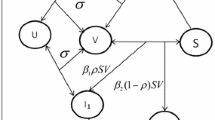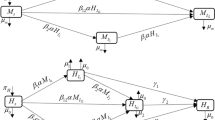Abstract
Dengue disease is a major public health problem in the world with a fast spreading rate. Human migration has contibute to spread of the different serotypes of dengue virus, incrementing the risk of dengue hemorrhagic fever and dengue shock syndrome. The disease immunological response is complex, with severe disease linked to the antibody-dependent enhancement. In this work we propose a system of differential equations to model the impact of human migration on the spread of two serotypes of dengue virus between two regions where only one of the serotypes was initially present. When the individuals to the other region they can contract a different serotype. Using the next generation matrix method, the basic reproductive number \(R_0\) is calculated and disease-free equilibrium stability is determined. In addition, conditions are obtained that guarantee the existence of an endemic equilibrium. These results provide conditions to predict an epidemic outbreak of dengue hemorrhagic due to a secondary infection of dengue.











Similar content being viewed by others
Data Availability
Not applicable.
References
Aguiar M., Anam V., Blyuss K. B., Estadilla C. D. S., Guerrero B. V., Knopoff D., Stollenwerk N.: Mathematical models for dengue fever epidemiology: a 10-year systematic review. Phys. Life Rev. (2022)
Agusto, F.B., Khan, M.A.: Optimal control strategies for dengue transmission in Pakistan. Math. Biosci. 305, 102–121 (2018)
Alzahrani, E.O., Ahmad, W., Khan, M.A., Malebary, S.J.: Optimal control strategies of zika virus model with mutant. Commun. Nonlinear Sci. Numer. Simul. 93 (2020)
Arino, J., Van den Driessche, P.: A multi-city epidemic model. Math. Pop. Stud. 10, 175–193 (2003)
Ben-Shachar, R., Koelle, K.: Minimal within-host dengue models highlight the specific roles of the immune response in primary and secondary dengue infections. J. R. Soc. Interface 12 (2015)
Ben-Shachar, R., Schmidler, S., Koelle, K.: Drivers of inter-individual variation in dengue viral load dynamics. PLoS Comput. Biol. 12 (2016)
Bhatt, S., Gething, P.W., Brady, O.J.: The global distribution and burden of dengue. Nature 496, 1–4 (2013)
Boulaaras, S., Jan, R., Khan, A., Ahsan, M.: Dynamical analysis of the transmission of dengue fever via Caputo-Fabrizio fractional derivative. Chaos Solitons Fract. X 8 (2022)
Camargo, F.D.A., Adimy, M., Esteva, L., Métayer, C., Ferreira, C.P.: Modeling the relationship between antibody-dependent enhancement and disease severity in secondary dengue infection. Bull. Math. Biol. 8, 83–85 (2021)
Clapham, H.E., Tricou, V., Van Vinh Chau, N., Simmons, C.P., Ferguson, N.M.: Within-host viral dynamics of dengue serotype 1 infection. J. R. Soc. 11 (2014)
Coudeville, L., Baurin, N., Vergu, E.: Estimation of parameters related to vaccine efficacy and dengue transmission from two large phase III studies. Vaccine 34, 6417–6425 (2016)
Diekmann, O., Heesterbeek, J.A.P.: Mathematical Epidemiology of Infectious Diseases: Model Building, Analysis and Interpretation. Wiley, New York (2000)
Dorigatti, I., McCormack, C., Nedjati-Gilani, G., Ferguson, N.M.: Using Wolbachia for dengue control: insights from modelling. Cell Press 34, 102–113 (2018)
Feng, Z., Hernández, J.V.: Competitive exclusion in a vector-host model for the dengue fever. J. Math. Biol. 35, 523–544 (1997)
Gakkhar, S., Mishra, A.: A dengue model incorporating saturation incidence and human migration. AIP Conf. Proc. 1651, 64–69 (2015)
Gao, D., Ruan, S.: A multipach malaria model with logistic growth population. SIAM J. Appl. Math. 72(3), 819–841 (2012)
Guzman, M., Gubler, D., Izquierdo, A., Martinez, E., Halstead, B.: Dengue infection. Nat. Rev. Dis. Primers (2016)
Guzmán, M.G., Kourí, G., Valdés, L.: Enhanced severity of secondary dengue-2 infections: death rates in 1981 and 1997 Cuban outbreaks. Rev. Panam. Salud Pública. 11, 223–7 (2002)
Instituto Nacional de Estadística, Geografía, e Informática, México, INEGI (2022). http://www3.inegi.org.mx
Jan, R., Khan, M.A., Gómez-Aguilar, J.F.: Asymptomatic carriers in transmission dynamics of dengue with control interventions. Optim. Control Appl. Methods 41, 430–447 (2020)
Khan, M.A., Ullah, S., Farhan, M.: The dynamics of Zika virus with Caputo fractional derivative. AIMS Math. 4, 134–146 (2019)
Mishra, A., Gakkhar, S.: Non-linear dynamics of two-patch model incorporating secondary dengue infection. Appl. Comput. Math. 19, 1–22 (2018)
Nikin-Beers, R., Blackwood, J.C., Childs, L.M., Ciupe, S.M.: Unraveling within-host signatures of dengue infection at the population level. J. Theor. Biol. 446, 79–86 (2018)
Ruan, S., Wang, W., Levin, S.A.: The effect of global travel on the spread of SARS. Math. Biosci. Eng. 3, 205–218 (2006)
Sebayang, A.A., Fahlena, H., Anam, V., Knopoff, D., Stollenwerk, N., Aguiar, M., Soewono, E.: Modeling dengue immune responses mediated by antibodies: a qualitative study. Biology (2021)
Shuai, Z., Van den Driessch, P.: Global stability of infectious disease model using Lyapunov functions. SIAM J. Appl. Math. 73, 1513–1532 (2013)
Van den Driessche, P., Watmough, J.: Reproduction numbers and sub-threshold endemic equilibria for compartmental models of disease transmission. Math. Biosci. 180, 29–48 (2002)
Weiskopf, D., Sette, A.: T-cell immunity to infection with dengue virus in humans. Front. Immunol. (2014)
World Health Organization: Dengue and severe dengue -key facts. https://www.who.int/news-room/fact-sheets/detail/dengue-and-severe-dengue
Yang, X.: Generalized form of Hurwitz-Routh criterion and Hopf bifurcation of higher order. Appl. Math. Lett. 15, 615–624 (2002)
Acknowledgements
The authors thank to the reviewers for their valuable comments that helped to improve the paper.
Funding
The first author thanks CONACYT for the scholarship granted.
Author information
Authors and Affiliations
Contributions
The authors have contributed equally to this work.
Corresponding author
Ethics declarations
Conflict of interest
The authors do not have any conficts of interest.
Ethics approval
Not applicable.
Consent to participate
Not applicable.
Consent for publication
The authors agree to publish this work.
Code availability
Not applicable.
Additional information
Publisher's Note
Springer Nature remains neutral with regard to jurisdictional claims in published maps and institutional affiliations.
Appendices
Appendix A: Positive Invariant Set \(\Gamma\)
We will see that the vector field on the boundary of \(\Gamma\) does not point to the exterior of the region.
It can be seen that in the hyperplanes \(S_i=0\), \(I_i=0\), \(R_i=0\), \(I_{ij}=0\), \(Z{ij}=0\), \(U_i=0\), \(V_i=0, \; i,j=1,2\) the components \(S_i\), \(I_i\), \(R_i\), \(I_{ij}\), Z ij, \(U_i\), \(V_i\) of vector field are positive and therefore the vector field points to the interior of \(\Gamma\).
Now, adding components of the human and vector population in system (1) we get
Using Gronwall inequality we have
Also
This shows that the solutions of system (1) remain in the set \(\Gamma .\)
Appendix B: Existence of an Endemic Equilibrium Point
An endemic equilibrium point \(P_3\) exists, if the conditions of the following propositions are satisfied.
Proposition 7
The values \(I_{12}^*\), \(I_{21}^*\), \(I_2^*\) and \(S_2^*\) are positive if
- i):
-
\(0<I_2^*<\dfrac{(m_{21}+\mu )(\gamma _1+\mu )\left( \mu \nu (\alpha (I_1^*+I_{21}^*)+\nu )+\alpha \beta _{21}\rho _1\Omega _1\right) I_{21}^*}{\alpha \beta _{21}\gamma _2m_{21} \rho _1 \Omega _1 (I_1^*+I_{21}^*)},\) and
- ii):
-
\(\dfrac{R_{01} S_1^*}{S_{01}}-1<\frac{\alpha I_1^*}{\nu }<\frac{R_{01} S_1^*}{S_{01}}, \text{ and } 0<I_1^*<r_{01}.\)
where \(r_{01}\) is the positive root of quadratic polinomial \(N_1\) (it is described in the proof).
Proof
From (2)
where
Then \(I_{12}^*>0,\) if \(h_{02}I_2^*>-h_{01}\), which is hypothesis i).
On the other hand, since
if \(\dfrac{\beta _1\Omega _1S_1^*}{(\gamma _1+\mu )\nu }-\dfrac{\nu }{\alpha }<I_1^* <\dfrac{\beta _1\Omega _1S_1^*}{(\gamma _1+\mu )\nu }.\) Substituting \(R_{01}=\frac{\alpha \beta _1 S_{01}^* U_{01}^*}{(\gamma _1+\mu )\nu }\) in \(\dfrac{\beta _1\Omega _1S_1^*}{(\gamma _1+\mu )\nu }\), we have \(\dfrac{R_{01} S_1^*}{S_{01}}-1<\frac{\alpha I_1^*}{\nu }<\frac{R_{01} S_1^*}{S_{01}},\) which is hypothesis ii).
By (2) we have that the sign of \(I_2^*\) and \(S_2^*\) are given by the sign of \(N_1\) and \(N_2\). Since \(N_2=\alpha \beta _{21}\gamma _2 m_{21}\rho _1\Omega _1(I_1^*+I_{21}^*)(\mu +m_{12}) \Big (I_1^*\left( \alpha I_{21}^*(\gamma _1+\mu ) (\mu +m_{21}) (\beta _{12} \rho _2\Omega _2+\mu \nu ) (\beta _{21}\rho _1\Omega _1+\mu \nu )+\beta _{21} \gamma _2\mu \nu ^2 m_{21}\rho _1 \Omega _1 \right) +I_{21}^*\left( \alpha I_{21}^* (\gamma _1+\mu ) (\mu +m_{21}) (\beta _{12} \rho _2 \Omega _2+\mu \nu ) (\beta _{21} \rho _1 \Omega _1+\mu \nu )+\mu \nu ^2 (\mu (\gamma _1+\mu ) (\beta _{12} \rho _2 \Omega _2+\mu \nu )+m_{21} ((\gamma _1+\mu ) (\beta _{12} \rho _2 \Omega _2+\mu \nu ) +\beta _{21} \gamma _2 \rho _1 \Omega _1)) \right) \Big )>0,\)
then \(I_2^*>0\) and \(S_2^*>0\) if \(N_1>0.\)
Note that \(N_1=h_{12}I_1^*{^2}+h_{11}I_1^*+h_{10}\) where
Furthermore, \(N_1=h_{12}(I_1^*-r_{00})(I_1^*-r_{01}),\) where
\(r_{00}=\frac{-h_{11}+\sqrt{h_{11}^2-4h_{12}h_{10}}}{2h_{12}}\) and \(r_{01}=\frac{-h_{11}-\sqrt{h_{11}^2-4h_{12}h_{10}}}{2h_{12}}.\)
Since
then \(N_1>0\) if \(0<I_1^*<r_{01}\), which is hypothesis ii). Therefore \(I_2^*>0\) and \(S_2^*>0.\) \(\square\)
Now, we will show that the polynomial equations of system (3) can have a positive solution. The quartic and constant coefficients of system (3) are
where
And the expression \(c_0\) is given below in the proof of Proposition 9.
Since \(e_4>0\) and \(f_4<0\), in order to have a positive solution, it is enough to find conditions to have \(e_0<0\) and \(f_0>0\).
Proposition 8
\(e_0<0\) if any of the following conditions are satisfied:
-
\(b_0\ge 0\) and \(S_1<\dfrac{a_0}{a_1},\)
-
\(b_0< 0\) and \(\Big (-\dfrac{b_0}{b_1}<S_1 \text{ and } S_1<\dfrac{a_0}{a_1}\Big ) \text{ or } \Big (-\dfrac{b_0}{b_1}>S_1 \text{ and } S_1>\dfrac{a_0}{a_1}\Big ).\)
Proof
Remember that
Since \(a_0>0\) , \(a_1>0\) and \(b_1>0\) then,
and
On the other hand, \(a_0-a_1 S_1<0, \text{ if } S_1>\dfrac{a_0}{a_1},\)
and
\(\square\)
Proposition 9
\(f_0>0,\) if the following conditions are satisfied:
-
\(\gamma _1+\mu \ge \gamma _2\) and \(\alpha >-\dfrac{c_{00}}{c_{01}},\)
-
\(0<I_1<r_{02}.\)
Proof
Since
we are going to show that the expression
is positive. Since
where
If \(\gamma _1+\mu \ge \gamma _2\) then
Thus
Since \(c_2<0,\) the parabola corresponding to the expression (B1) opens downwards. Therefore
where \(r_{02}\) is the positive root of (B1) \(\square\)
Appendix C: Global Stability of the Disease-Free Equilibrium
We define the following function to demonstrate the global stability of the equilibrium point \(P_0\):
From the above, we note that \(f(x,y)\ge 0\), for (x, y) in \(\Gamma .\)
We will built a Lyapunov function following Shuai and van den Driessche technique [26, 27]. For this, we consider the following matrix.
The characteristic polynomial of \(T^{-1}F\) is,
Therefore the spectral radius of \(T^{-1}F\) is equal to
where
If \(w=(w_1,w_2,w_3,w_4)\) is a left eigenvector associated with the eigenvalue \(R_0\) of \(T^{-1}F\) then it satisfies the following equations.
We have three cases \(R_0=\sqrt{R_{01}}\) or \(R_0=\displaystyle \sqrt{R_{02}}\) with \(\displaystyle \sqrt{R_{01}} \ne \sqrt{R_{02}}\). And \(R_0=\displaystyle \sqrt{R_{01}}=\sqrt{R_{02}}\)
Case \(R_0=\sqrt{R_{01}}>\sqrt{R_{02}}.\)
From (C4), \(\Big (R_0-\dfrac{R_{01}}{R_0}\Big )=\Big (\sqrt{R_{01}}-\sqrt{R_{01}}\Big )=0.\)
From (C5), \(\Big (R_0-\dfrac{R_{02}}{R_0}\Big )=\dfrac{1}{\sqrt{R_{01}}}\Big (R_{01}-R_{02}\Big )\ne 0\) if \(R_{01} \ne R_{02}.\) Therefore \(w_4=0.\)
Taking \(w_2=1\) and substituting in (C2) and (C3) we have
Since \(x^T=\left( I_1,V_1,I_2,V_2\right) ,\) we define the Lyapunov function as
It is clear that \(Q_1(x)\ge 0\) and \(Q_1(x)=0\) if and only if \(x=0.\)
Moreover,
where \(A_1=\left( S_{01}^*-S_1\right) \frac{\alpha U_{01}^*\beta _1V_1}{R_0\nu (\gamma _1+\mu )}+\left( U_{01}^*-U_1\right) \dfrac{\alpha I_1}{\nu }\ge 0\), since \((x,y) \in \Gamma .\)
Therefore \(\dot{Q_1}<0\) if \(R_0<1.\)
Case \(R_0=\sqrt{R_{02}}>\sqrt{R_{01}}.\)
In the same way as above, we have that the Lyapunov function is
where \(A_2=\left( S_{02}^*-S_2\right) \frac{\alpha U_{02}^*\beta _2V_2}{R_0\nu (\gamma _2+\mu )}+\left( U_{02}^*-U_2\right) \dfrac{\alpha I_2}{\nu }\ge 0\), since \((x,y) \in \Gamma .\)
Case \(R_0=\sqrt{R_{01}}=\sqrt{R_{02}}.\)
The left eigenvector associated with the eigenvalue \(R_0\) of \(T^{-1}F\) is
From above we have that
is a Lyapunov function. Moreover \(\dot{Q}<0\) since \((x,y) \in \Gamma .\)
Therefore \(P_0\) is globally asymptotically stable if \(R_0<1.\)
Appendix D: Stability at \(P_1\) or \(P_2\)
The characteristic polynomial of Jacobian matrix evaluated at the equilibrium point \(P_{1}\) is
Where
Note that \(q_1, q_2, q_3, q_4 \in \mathbb {R}^{+}\) and
Using Mathematica we obtain
which is always positive.
\(D_4=q_4D_3>0.\)
By the Routh-Hurwitz criterion [30], we obtain that all roots of \(L^4+q_1 L^3 +q_2 L^2 +q_3 L +q_4\) have negative real part. On the other hand
if
By the Routh-Hurwitz criterion, we obtain that all roots of quadratic polynomial have negative real part.
Therefore, if \(R_1\left( \frac{S_{11}^*}{S_{01}^*}+\frac{\rho _1\beta _{21}Z_{121}^*}{\beta _1S_{01}^*}\right) <1\) then \(P_1\) is locally asymptotically stable.
In the same way, we have that if \(R_2\left( \frac{S_{22}^*}{S_{02}^*}+\frac{\rho _2\beta _{12}Z_{212}^*}{\beta _2 S_{02}^*} \right) <1\) then \(P_2\) is locally asymptotically stable at \(\Gamma .\)
Appendix E: Expressions for \(F_1\) and \(F_2\)
Rights and permissions
Springer Nature or its licensor (e.g. a society or other partner) holds exclusive rights to this article under a publishing agreement with the author(s) or other rightsholder(s); author self-archiving of the accepted manuscript version of this article is solely governed by the terms of such publishing agreement and applicable law.
About this article
Cite this article
Vinagre, M.R., Blé, G. & Esteva, L. Dynamical Analysis of a Model for Secondary Infection of the Dengue. Differ Equ Dyn Syst (2023). https://doi.org/10.1007/s12591-022-00628-5
Accepted:
Published:
DOI: https://doi.org/10.1007/s12591-022-00628-5




